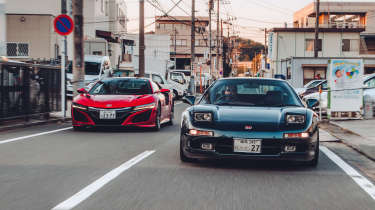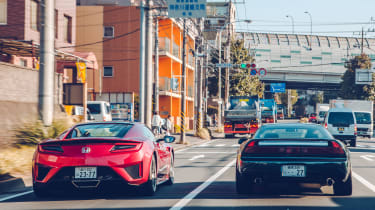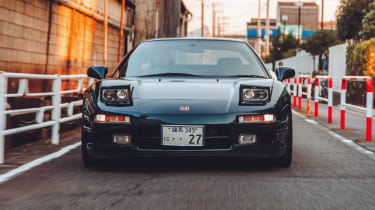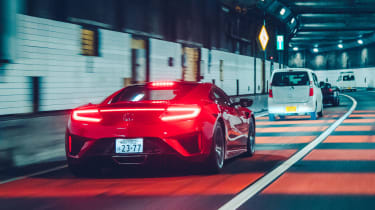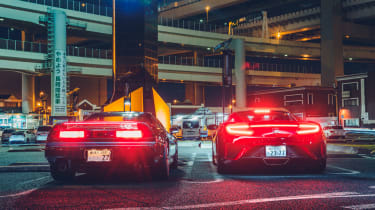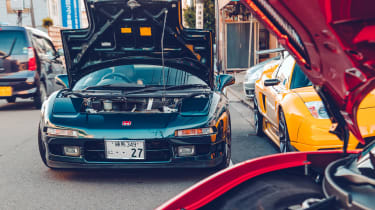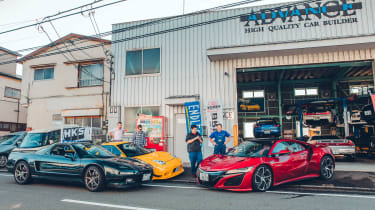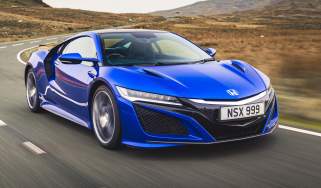Old vs new: Honda NSX Tokyo shootout
We drive the first and last Honda NSXs in Tokyo to see if the adoration is universal across the generations.
For just a moment I’m fourteen again, staring at the distinctive trapezoid tail lights of a Honda NSX. Six small oblongs illuminated behind a band of red polycarbonate, joined by an extra sliver of LED light emanating from the trailing edge of the integrated spoiler with every tap of the brakes. I can just about hear the growl of its twin tailpipes over the mechanical gnashing behind me, reverberating off the long walls of every tunnel on Tokyo’s seemingly endless ribbons of expressway.
The reverb disappears as we emerge onto long raised stretches of road between monolithic apartment blocks, punctuated by the occasional flicker of light from an occupied room. Now and then we scythe across the metal span of a bridge, skyscrapers and a lone ferris wheel lining the horizon as orange fades into hazy purple. In my head it’s a screenshot from Gran Turismo, rendered in 3D and with perfect clarity, one that takes me back to those evenings spent with PlayStation controller in hand, racing my brother to the finish line (and generally losing).
Right now, from my vantage point in the current NSX, the power advantage is all mine. But I’ve no idea where I’m going, and there’s not a single character I recognise on the satnav screen as it chirps back to me in a kawaii anime-girl voice: ‘Massugu itte, shingōde hidari ni magatte kudasai.’ Quite. Arigatou gozaimasu, but I think I’ll just follow. On a different day, though, 573bhp would put me just a pedal-squeeze away from dominating the Bayshore Route Grand Prix...
Such are the fruits of two and a half decades of progress. The latest NSX is a bona fide supercar in all but bonnet emblem, where its predecessor only just scraped that definition – even if it did drop a dollop of wasabi into whatever it was that complacent European manufacturers were dining out on at the time. Porsche 964s and Ferrari 348s are appreciated today as characterful dips back into the history of their respective manufacturers – not to mention decent investments – but Honda’s all-aluminium, VTEC-engined arrival revealed them as unsophisticated anachronisms, relics from a time when flaws were considered an acceptable compromise for their performance.
The first NSX was lightweight, compact, and thoughtful. It’s become a cliché to say it was little more taxing to drive than a contemporary Civic, but it remains true. The steering is light, if not quite so friction-free and direct as a modern sports car’s, the forward visibility astonishing. By current standards, it’s also tiny, mainly in width. The analogue instruments are legible, the seats comfortable, and you can get in and out of it without having to clamber over a massive sill or through some dihedral- hexadecimal-logarithmical porthole.
> Honda S2000: review, history and specs of an icon
Today’s NSX must work harder to compete: 911s and 488s (and R8s and 570Ss) aren’t just blisteringly fast but everyday-useable. Supercars without compromise, just as the first NSX was back in 1990. Porsche, Ferrari and others have taken Honda’s USP and paired it with the heritage and showroom appeal that even their flaky ancestors never lacked.
Today’s approach is different, and New Sportscar eXperimental seems even more appropriate now than it did back then (actually, today it’s New Sports eXperience, but we’re sticking with the original backronym, thanks), with hybrid technology to assist the NSX’s twin- turbocharged V6, all-wheel drive, torque vectoring, and nine-speed dual-clutch gearbox. Big power, big torque, and big sophistication, plus a cabin that keeps the original’s simplicity while incorporating the necessary modern kit, and a sense of compact useability, even in Tokyo’s tightest streets, to body-shame a 991.
But the new NSX is hiding a dirty secret to those of us who grew up with a JDM schooling thanks to Gran Turismo and Tokyo Drift: it’s American. Its creases are the work of Acura’s Michelle Christensen and engineering was led by Ted Klaus; both American. The concept was first revealed at Detroit in 2012 and the production car debuted at the same show in 2015. It’s built not in Tochigi, like the original, but in Marysville, Ohio.
Car fans in Tokyo are either unaware of its American heritage or aren’t bothered. Parked up earlier, near the Kanda River – cheekily in front of Toyota’s headquarters – the new NSX attracted just as much attention as its ancestor. A businessman in a tailored brown suit stopped by to compliment the cars in broken English. I motioned as to which might be his choice – old or new? He pointed to the red car.
Blake Jones, owner of the older, Brooklands Green Pearl model in front and writer for car culture website Speedhunters, is also making positive noises when we park up on the other side of one of Tokyo’s many tollbooths (whose operators offer encouraging noises of their own each time we pull up). He tells me how fantastic the new car looks in his rear-view mirror. Not as good as his car looks above my squared-off wheel, I suspect, but he has a point.
The new NSX’s long gestation and numerous show appearances mean it’s a familiar shape now, but on a crisp late- October morning in Tokyo the NSX cuts a striking form. That might be down to the Valencia Red Pearl paintwork, or it might be the small oblong Japanese number- plate up front, which photographer Mark Riccioni has already noted improves the look of everything from the humble Honda Jazz to the evo-kryptonite Prius.
As with the original, the new car is surprisingly compact in the metal. It sits waist-high, and has the unmistakeable proportions of a supercar. The details of one, too, from the multi-element LED headlights and the mid-mounted V6 visible through the rear glass, to the mirrors out on stalks and the buttresses rising above the vents in the rear wings.
But while one NSX owner might be impressed on first acquaintance, we have bigger sakana to fry. Blake is leading me to Advance Garage, one of thousands of tuning firms dotted across Japan and a particular specialist with the original NSX, building time-attack cars capable of lapping Tsukuba Circuit in under a minute – serious speed for a street-legal vehicle. Our choice of venue may not be unrelated to Blake’s desire to swap a manual transmission into his automatic example in the near future.
There’s a little more highway to cover first, and it’s a mixed bag. At Tokyo’s languid traffic velocities, the new NSX is on hybrid duty, six-pot kicking in and out with throttle input, saving fuel at every opportunity. I appreciate the sentiment – it seems appropriate in a country where even the cheapest cars feature mild-hybrid tech and the dirt and clatter of diesel engines is largely absent – but Honda’s latest V6 isn’t as sonorous as before and at low cruising revs the sound is nothing more musical than a mechanical thrash. As with so many hybrids, petrol power feels like the weak link.
Blake, familiar with the roads, decides it’s time to step up the pace. Thank God sixty-odd isn’t the norm here. I’ve no intentions to join the Midnight Club, but Tokyo’s glassy-smooth asphalt and race- track-cambered turns invite a much faster flow. Bigger numbers begin to show on the TFT speedometer, and higher revs on the concentric tacho. Now the NSX feels happier. Sounds a bit more like a supercar – not a wail or a bellow, but purposeful, almost tuneful. Makes amusing turbo chuffing noises under heavy throttle and on the overrun. Still feels smooth and seamless. Still isn’t quite as cool as the early-’90s icon slinking along in front.
I clock the cars before I see the garage itself. Parked out on the street is a third- generation Mazda RX-7 wearing a few choice modifications and a glossy coat of black paintwork. Hidden behind is an S15 Nissan Silvia – a shape never sold in the UK – and up on the kerb is one of Advance’s most famous project cars, the yellow ‘Flatout’ demo NSX. The shop has owned it since 1997, originally buying it to develop parts of its own, and its visual distinctions include some faired-in headlights from a later car, a wide, custom bodykit, and a set of staggered Rays wheels tucked under the arches. Through the rear Plexiglas are visible six velocity stacks for individual throttle bodies, helping towards a naturally aspirated 340bhp or so. Before I’ve even pulled up, proprietor Masa walks out with a big grin and motions me to park at a jaunty angle in front of the open entrance.
By Japanese standards, the Advance workshop is sizeable, but it’s still cosy enough that cars are perched on lifts not just to be worked on, but to allow space beneath to fettle other customer projects. A silver NSX is parked front and centre, also wearing a wide bodykit and a sizeable diffuser, while in front are two more, the first silver, with a pearlescent white example dangling its wheels above. To the side is a Bayside Blue metallic R34 Skyline GT-R waiting for R35 brakes, while up on the ramps are a Legacy and a 370Z hiding a serious-looking roll-cage and carbonfibre body panels. Little is for decoration; Advance customers use their cars on track. Several boast stickers from the nearby Fuji Speedway.
> Nissan Skyline GT-R R34: review, history and specs of an icon
I want Masa’s take on the new car, but first he wants his mechanic to try it. I give him the thumbs-up. These guys are used to actual handbrakes and manual gearboxes, so I have to gesture towards the small circle marked D/M and the handbrake switch behind it. He then pulls away silently, which must be a novelty for Advance’s neighbours. After a spin around the block, Masa hops in and does the same. They’re all smiles. ‘It’s fast!’ they beam. Masa says one of his customers has a new NSX, but they only do basic maintenance on that, and it’s the first time either has had a drive. Up goes the (front) bonnet, revealing a chaotic space full of wires, hoses and subframes – not unlike the old car – then the rear clamshell pops and Masa stares past the pokey luggage area at the mostly-hidden V6. They peer and prod away, and Blake conveys their occasional message of approval.
But is it a proper NSX? They aren’t so sure. With good humour but a hint of exasperation, Masa explains that it doesn’t feel like the old car. Neither to drive, nor in spirit. In fact, he says, it feels American. You don’t really need to rev the engine, he notes, the implication being that big, low-down torque (thanks to the electric motors) is a very American characteristic. Realistically, it also has a bit too much power for crowded Japanese roads. Great on track, he supposes, but not something you can exploit like you can with the original car.
Blake nods. ‘For the price I paid for my NSX, you can get a used R35 Nissan GT-R in Japan’, he says. ‘But that just doesn’t appeal to me.’ Everyone here – including myself, I concede – prefers the more accessible but also more involving performance of the earlier car. One word comes up over and over in conversation, and it’s a word I understand as the western motoring lexicon is absorbed into Japanese: digital. At the time, the original NSX might have seemed inorganic next to some of its more boisterous rivals, but by modern standards – even considering steering that feels quite numb at lower speeds – the old car feels more like a living object next to the new NSX’s clinical, digital approach.
> Nissan Skyline GT-R R33: review, history, prices and specs
Would Advance Garage ever modify the new NSX? Some of Japan’s more visually orientated tuners have already tackled it, and the turbocharged engine certainly lends itself to even bigger numbers. Masa shakes his head. They’ve worked with the original NSX since the mid-’90s but, to him, the new car feels like an interloper. A remarkable supercar and, like the original, an impressive technical achievement. But not really an NSX.
I mull on this as Blake and I head to the Daikoku-Futo parking area to get a few last photographs. On Tokyo’s looping network of expressways, roads highlighted in sodium vapour orange, the videogame vibes are stronger than ever. Street signs flicker and perfectly painted road markings reflect vividly in the LED headlights’ glow, the early NSX still dancing, howling through every tunnel.
Back when Gran Turismo debuted in 1997, it felt like a game that only Japan could produce. Impossibly detailed, idiosyncratic, slightly geeky. It nevertheless won worldwide acclaim, changing the way people thought about and developed racing games. The latest in the franchise, Gran Turismo Sport, is a highly impressive, more refined, more bombastic product, with global ambitions in the face of stronger rivals. The parallels are clear. As with Gran Turismo, the NSX’s Japanese roots are beginning to fade.

